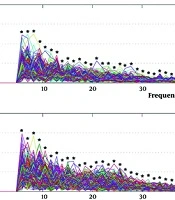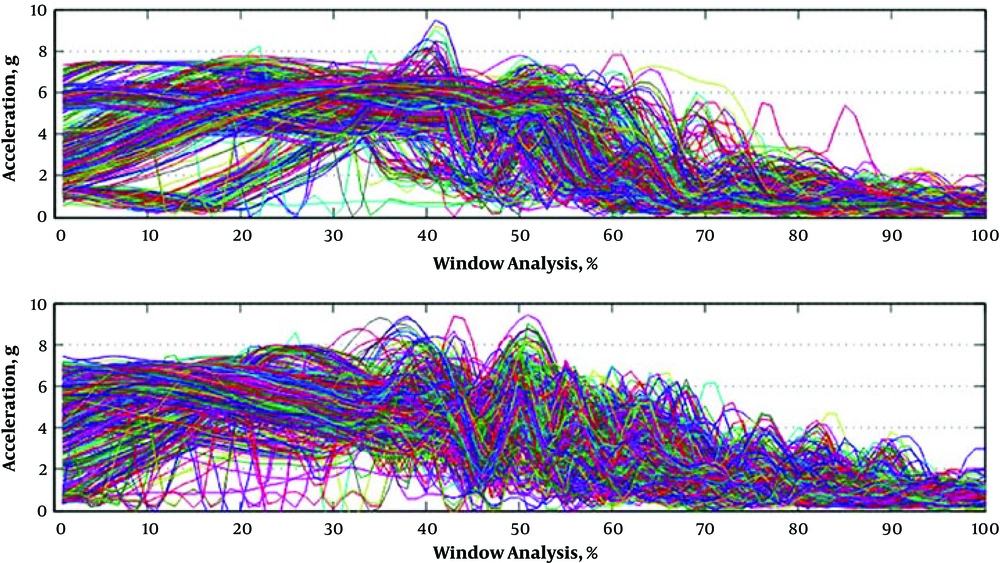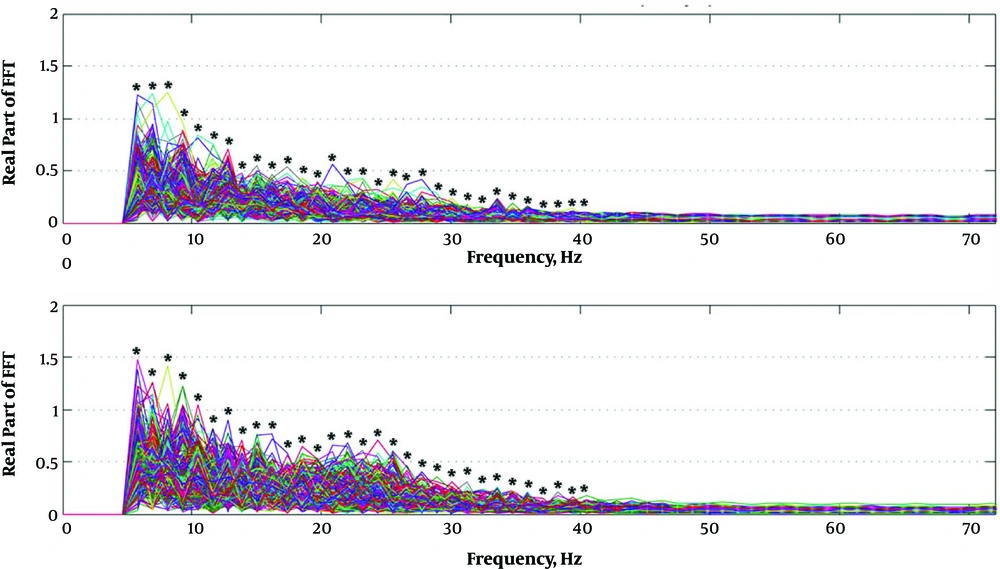1. Background
Between 17% - 70% of runners will develop pain along the inner edge of the shinbone (tibia) (1-3) leading most to withdraw from running practice (1). In runners, The American Academy of Orthopaedic Surgeons defines this pattern of pain as “shin splint” (1). Traditionally, rest, anti-inflammatory medicine, rehabilitation, sports footwear change, and insoles are indicated for pain relief and control of the inflammation process, and to diminish the stress on tibia caused during running (4-6). Unfortunately, the stress attenuation protocols and insole designs are frequently prescribed using rudimentary guidelines (7).
The effectiveness of using custom insoles tailored to the contours of barefoot pressure distribution and the shape of foot for the reduction of peak forces during gait was previously demonstrated in patients with diabetes (Owings et al., 2008), and may be an effective method to control the impact after shin splint in runners. During running, impact on the tibia occurs 150-ms after rearfoot contact (8). After that, superior structures can be affected by mechanical resonance due pathological load-deformation cycles (5). Computed tomography, dual energy X-ray absorptiometry, and magnetic resonance images support an anabolic reaction at the distal third of the tibia in runners (9, 10).
Due the above factors, opportune removal of energy in the tibia bone tissue is crucial and depends on the amplitude and frequency of the wave propagation (11), where increased vibration caused by greater source perturbation (i.e. impact force) could induce a local anabolic reaction. Therefore, footwear and insoles which could be classified as non-biological dampers need to attenuate the source of vibration to be effective. This attenuation could be observed in a time-series signals, however Shorten (12) described that the impact signal in the frequency domain gives information about muscular activity (low frequency components, ≤ 8 Hz) and impact (medium frequency components, 12 - 20 Hz) (8). Here, we hypothesized that custom insoles tailored to the contours of barefoot pressure distribution and the shape of the foot may be effective for diminishing impact, with change both in the time and frequency domains of accelerometry signals.
2. Objectives
The aim of this study was to determine the effects of cushioned (footwear with custom insoles) and non-cushioned (barefoot) running on impact in 10-km runners rehabilitated for unilateral shin splint. Lower impact and different frequency spectrums were observed in participants using footwear with custom insoles as compared to participants running barefoot.
3. Methods
This cross-sectional study was carried out at the Instituto Traumatologico (Santiago, Chile). To study the effect of footwear with custom insoles on impact compared to a control condition where only biological dampers are present (barefoot running) in 10-km runners with rearfoot contact and overpronation, accelerometry signals were obtained. Participants, immediately after six weeks of rehabilitation, performed 5 minutes of running on treadmill in random order (cushioned and non-cushioned condition) while tridimensional accelerometry data at the rearfoot level were acquired.
3.1. Participants
This study included 20 participants (Table 1). The study had no dropouts, and to obtain a standardized effect size of 0.72 with a statistical power of 80% and 5% chance of type I error, twelve participants were needed, considering a possible 40% rate of dropouts. The inclusion criteria are summarized in Table 2.
| Basic anthropometric characteristics | Valuesa |
|---|---|
| Age, y | 30.5 ± 9.3 |
| Height, m | 1.74 ± 0.03 |
| Weight, kg | 71.5 ± 6.0 |
| Body mass index, kg/m2 | 23.4 ± 2.0 |
| Contact frequency, Hz | 0.76 ± 0.10 |
Runner Characteristics (N = 20)
All participants gave written informed consent prior to participation and were able to withdraw from the study at any time without any consequences. The study was approved in accordance with principles established by the Helsinki Declaration by the Scientific Ethical Committee at Instituto Traumatologico (Santiago, Chile).
| Inclusion Criteria | Exclusion Criteria |
|---|---|
| Male | Orthopedic deformations |
| 10 kilometer runner | Any lower limb musculoskeletal injury |
| Rearfoot runner | Lower limb pain |
| Overpronator | Cognitive impairments |
| Age between 20 to 45 years old | Overweight (BMI > 25) |
| Unilateral recurrent shin splint | Corticosteroid therapy history |
| Asymptomatic running assessment | Metabolic dysfunction history |
| Written consent | Previous shin stress fracture |
| Insole comfort |
Eligibility Criteria for the Study
3.2. Diagnosis and Rehabilitation
One senior orthopedic foot and ankle surgeon (HH) and a second senior orthopedic knee surgeon (HM) medically diagnosed shin splint in the participants (pain at distal third of the tibia without signs of edema or stress fracture in magnetic resonance images). Each patient was prescribed an oral 400 mg dosage of a non-steroidal anti-inflammatory to be taken every eight hours for the first five days to reduce acute symptoms.
After medical diagnosis, each participant completed a six week rehabilitation program (13). This program included the following: in week one, rest from sports related activities, inflammation control, pain control (cryotherapy and transcutaneous electrical nerve stimulation), and plantarflexion stretching; in week two, inflammation and pain control continues, with improvement of ankle muscle flexibility, isometric ankle strengthening, and star excursion training; between weeks two and five, inflammation and pain control continues, with improvement of ankle muscle flexibility, eccentric ankle strengthening, and star excursion training; and in week six, plantarflexion stretching, aerobic reconditioning, footwear modifications, eccentric strengthening with emphasis on ankle invertors, reincorporation of treadmill running, and cryotherapy after each running session (13).
Six weeks after medical diagnosis, each participant changed their running footwear for neutral cushioned running footwear (Asics America Corp., USA) equipped with custom insoles designed to decrease the overpronation and overpressure of each participant’s footprint. The insoles were designed using pedobarography data (RScan International NV, Belgium) created by a senior foot specialist using shock absorber poron material (FootSolution, Chile). Seven days before running assessment, all participants used the custom insoles for at least two hours every day during their daily activities.
3.3. Insole Design
To obtain the peaks of pressure, an assessment of pressure distribution during running was carried out by acquiring data through a pressure platform (RSscan International NV, Belgium). The platform has 4096 sensors arranged in a matrix of 64 × 64, a resolution of 8 bits and 300 Hz of sample frequency acquisition. The insoles were reinforced with shock absorber poron material tailored to contours of the barefoot pressure distribution and shape of the foot. Furthermore, all patients received rear-foot and medial arc stabilization according to the volume of each foot. The standardization of procedures was designed to diminish sources of bias in the study.
3.4. Accelerometry Assessment
The 3-axis ADXL345 accelerometer (Analog Devices Inc., USA), with high resolution (3.9 mg/LSB) up to 16 g, 10X amplification, and a wireless connection (13), was created and used with an Arduino microcontroller (Arduino, Italy). The accelerometer was aligned with the calcaneus while in a bipedal posture and in relation to its medio-lateral and cephalo-caudal axes. This setup was used to obtain accelerations experienced by the rearfoot. The signals were taken at a sample frequency of 1000 Hz with a 16-bit converter for storage using Matlab V. 7.0.1 software (Mathworks Inc., USA).
Thirty consecutive initial contacts were identified from frequency analysis using a wavelet transformation described by Aung et al. (14), in relation to the accelerometer signal of the rearfoot with the Daubechies 4 wavelet function in Matlab V. 7.0.1 (Mathworks Inc., USA). To create the impact signal from the initial contact, data was normalized (second/second) as described in Figure 1. For frequency domain analysis, all signals were treated by Fourier transformation using the Fast Fourier algorithm of the signal processing toolbox of Matlab V. 7.0.1 (Mathworks Inc., USA).
3.5. Running Trial
Participants ran under randomly selected cushioned and non-cushioned conditions. The participants started with a 2 minutes warm up at 3.0 m/s. If they needed more time to get used to the treadmill (Techno gym Spa, Italy) they practiced for a longer time. The running assessment was performed with a speed similar to the speed they used to practice at before the shin injury, and had duration of 5 minutes with a rest time of 10 minutes between conditions.
3.6. Outcomes
To determine the outcome of the impact, the maximum value of the quadratic root of the sum of versors squared (impact signal) was used to obtain the impact variables for the cushioned and non-cushioned conditions (Equation 1) (13). In turn, the outcome of the frequency spectrum was obtained from the signal in the time-domain, as based on the fast Fourier transformation algorithm in Matlab V. 7.0.1 (Mathworks Inc, USA). Finally, to determine the outcome of the reconstructed time-domain impact signals for statistical differences between cushioned and non-cushioned conditions, the inverse Fourier transform was used based on the algorithm in Matlab V. 7.0.1 (Mathworksinc, USA).
3.7. Statistical Analysis
Data are expressed as the mean ± standard deviation. Against missing accelerometry data, a spline interpolation was be used to reconstruct nan of the signals. The impact signals (3600 signals; from 20 runners × 2 conditions × 3 channels × 30 windows) were analyzed for normality and homoscedasticity using the Shapiro-Wilk and Levene’s tests, respectively. As data were normally distributed with equal variance, a one-tailed paired t-test with a 5% alpha error for variable impacts was used to compare cushioned and barefoot running. To compare the spectrum frequencies between groups, repeated measures ANOVA and Bonferroni’s post-hoc analysis with a 5% alpha error were performed. For calculus comparison, the frequency domain vector was discretized every 1.2 Hz. Finally, a correlation analysis was performed between the reconstructed time-domain impact signal and the impact signal with a 5% alpha error. All statistical analyses were carried out with the STATA V. 12.0 software (Stata Corp., USA).
4. Results
This study included 20 participants, with no dropouts (Table 1). 34 patients were initially screened, 20 of which were confirmed eligible and included and analyzed in this study. There was no missing data for any of the variables in this study. Impact was reduced from 6.9 g to 6.5 g with the cushioned condition as compared to control (95% CI: 6.4 g - 6.6 g, P < 0.001). The spectrum frequency was lower when using cushioned condition in the band between 5.8 and 40.5 Hz (P < 0.001), however no differences existed between conditions in the bands from 0 to 5.8 Hz and 40.5 to 500 Hz (P > 0.05), as shown in Figure 2. The reconstructed time-domain impact signals had correlation coefficients equal to 0.38 ± 0.21 and determinant coefficients equal to 14.3% against the original impact signal (P < 0.05), explained by a lower percentage of vibration phenomena during the initial contact of the rear-foot with floor during running, as summarized in Figure 3.
Frequency domain signals. Frequency spectrum of cushioned condition (top) and non-cushioned condition (bottom). The spectrum range was presented up to 72 Hz. The first range (0 - 5 Hz) was suppressed to visualize the 5 - 72 Hz band, where differences between the spectrums were concentrated. FFT = fast Fourier transform. * indicates statistical significance (P < 0.001).
5. Discussion
The main finding of this study was that there was an attenuation of impact when using a cushioned condition after shin splint during running in 10-km runners, both in the time and frequency domains. Impact generated during the initial contact (5, 15) starts a vibration phenomenon in tissues that occurs more frequently in rearfoot runners (5). This can cause harmful pathological vibrations that are transferred to the tibia, resulting in the generation of a bone reabsorption process (16). In this study, we found that the use of footwear and custom insoles specialized to pressure distribution and foot shape are appropriate to diminish impact after rehabilitated shin splint during running. Knowledge of this effect is crucial for adding protection during the reinstatement of running in injured runners, while physical therapists and trainers have to re-establish the appropriate action of biological dampers (muscles and tendons) that cause dysfunction in shin splint.
The lower impact obtained in this study is in agreement with Nigg and Liu (17), Lafortune and Henning (18), and Akins et al. (19), which tested different kinds of insole. This shock attenuation is also confirmed by the meta-analysis of Mills et al. (7), who established that molded orthoses, in accordance with our proposed design based on distribution of foot pressure, produced large reductions in loading rate and vertical impact force. Nevertheless, these positive results were not supported by the systematic review of Fong et al. (4) who determined that cushioned running footwear is not capable of modifying reaction force or its maximal values. Previously, these contradictory results on impact measurements were described by Shorten (12), suggesting that there is an unconsidered source of variability in studies of footwear during running related to subtalar mechanics and neuromuscular changes, which need to be addressed. These combinations of pure mechanical phenomena (insoles and footwear) and neuromuscular responses are a source of variability in the data, increasing the chance of a type-2 statistical error, wherein more samples are needed to obtain adequate statistical power to detect existing differences.
The spectrum findings between 5.8 and 40.5 Hz showed a decrease in the spectrum when using cushioned running footwear with custom insoles as compared to the control barefoot condition in participants treated after six weeks of traditional shin splint rehabilitation. In accordance to spectrum categorization outlined by Shorten and Winslow (8), in this study both muscular (lower frequency) and mechanical (medium frequency) components of the impacts were recognized as supporting the acute adaptation of the musculoskeletal system against the insoles (20). Furthermore, when the statistical bands were reconstructed by the inverse Fourier transform (Figure 3), only 14.3% of the reconstructed signals explained the raw impact signals in the temporal domain. Despite a decrease in the spectrum, the reconstructed signal explains only a low percentage of the vibrational behavior for raw signals. Therefore, we interpret that the use of the cushioned condition in this study may not fully change the vibration behavior of runners. This could be a result of neuromuscular inefficiency and non-optimized actions of runners during the trial.
The findings of our study generate new questions as to whether lower impact alone represents successful rehabilitation after shin splint, and whether the traditional therapeutic approach can modify the damping behavior of the lower limb. Based on the damping theory, dampers can modify vibrations when perturbation is diminished and the frequency of perturbation is constant (11). Research into the neuromuscular muscle tuning concept (21) supports the dynamic action of muscles, which are the main musculoskeletal dampers. This suggests that impact is only one part of a complex neuromechanical scenario that needs to be considered when planning therapeutic objectives and the prevention of future tibia stress in the treatment of medial stress syndromes. Future research should consider factorial designs with and without insoles, as well as assess different rehabilitation models. Further studies also need to explore the damping coefficients associated with different rehabilitation plans, the causality between impact and medial stress syndromes, the neuromuscular role associated with pathological resonance phenomena during running to provide novel and detailed clinical answers for recurring shin splint pathology. A limitation of this study is that no analysis of confounding variables was performed regarding the possible interaction between physical and social characteristics of the sample patients. The overall strength of this study in terms of the use of appropriate statistical power, the randomization of trials, and the sensitive digital acquisition provide arguments for the generalizability of our findings in terms of 10-km runners treated with traditional rehabilitation after shin splint.
5.1. Conclusions
Running footwear with custom insole design reduces impact during running, establishing an appropriate strategy to diminish tibial stress after shin splint in runners.



